#1940s décor
Text

Pour ce trente-cinquième épisode de l'émission La Libre Antenne sur ERFM, le camarade Blaise et la section Égalité & Réconciliation des Pays de la Loire m'ont convié à évoquer la praxis du bien vivre en ville en ce début de XXIe siècle... Merci les gars.
Sommaire et musiques:
01- Introduction
4 min 10 : Devienne - Sonate pour flûte, basson et piano
02- Le Prince et la Cité
12 min 06 : Devienne - Sonate pour flûte, basson et piano
03- Style urbain français entre 1840 et 1940
16 min 44 : Rameau - Les Fêtes de Polymnie – Ouverture
04- Paris nomadisée
20 min 42 : RAMEAU - Le Temple de la Gloire - Ouverture
05- Envers du décor et ascenseur
24 min 49 : Marais - Alcione - Deuxième Air des Matelots et Matelotes
06- Les HLM des années 1950-60
27 min 40 : Grétry - Richard Cœur de Lion – Ouverture
07- Banlieue parisienne
29 min 44 : Grétry - La caravane du Caire – Ouverture
08- La ville dortoir
31 min 19 : Philidor – Tom Jones - Ouverture
09- L’esthétique désolée
35 min 38 : Méhul - Symphonie No. 2 en D majeur - Andante
10- Exigence contre décadence
39 min 34 : Saint-Saëns - Bacchanale
11- La propriété comme bouclier
43 min 20 : Saint-George - Ernestine – Ouverture
12- Londres et les magasins provisoires
46 min 44 : Berlioz - Marche hongroise
13- Le ministère de l’Embellissement
49 min 44 : Méhul - Adrien – Ouverture
14- L’ameublement masculin
52 min 37 : Gounod - Symphonie No. 2 - Allegro agitato
15- Le mobilier sprezzatura
56 min 10 : Fauré - Pavane - Andante Molto Moderato
16- Les magasins de mobilier
58 min 56 : Gossec - Symphonie en D Majeur - Minuetto & Trio
17- Le mode d’éclairage intérieur
1 h 02 min 16 : Fauré – Sicilienne
18- La campagne française violée
1 h 04 min 45 : Ravel - Le tombeau de Couperin – Prélude
19- Le rapport de l’homme à la campagne
1 h 13 min 13 : Jaubert - Le Jour se lève
20- Henri Sellier
1 h 16 min 17 : Saint-George - L’Amant anonyme - Ouverture I. Allegro presto
21- Les smart cities
1 h 21 min 00 : Gossec - Symphonie en D Majeur – Allegro
22- Conclusion
1 h 24 06 : New Order - The Himm
#ERFM#Paris#France#Tradition#Haussman#parisian style#parislife#architecture#Urbanisme#décoration#Décoration d'intérieur#Design#Podcast#Egaliteetreconciliation.fr#Pays de la Loire#Charles III#Prince Charles#Riad Sattouf#Sempé
13 notes
·
View notes
Text










Maiden Voyage of the SS NORMANDIE
Finally on May 29 1935 , NORMANDIE was ready to depart on her greatly anticipated maiden voyage. In Command was of course the French Line’s Commander of their new flagship, Captain René Pugnet, who had briefed his officers and staff ensuring it would be a smooth and a perfectly run operation throughout the voyage.
As her guests commenced to arrive dockside, she slowly began to fill with happy passengers all of whom were looking forward to an exciting voyage across the Atlantic. As they boarded the world’s largest liner and having been promoted as being a super luxury Ocean Liner, all her guests had much to look forward to as they departed sailing via Plymouth and then headed for New York on this remarkable liner.
The clipper-like bow, the streamline-shaped superstructure and the three teardrop-shaped funnels – all aligned in perfect harmony and aesthetic perfection. And the forecastle was a masterpiece in itself. With very little gear visible behind the teak-coloured whaleback, the decks were clean and uncluttered.
When the Normandie left on her maiden voyage from Le Havre to New York on May 29, 1935, she was the largest, most innovative and fastest ocean liner afloat.
Her powerful engines were unleashed at high speed yet they were very quiet Compared to all other ships.
Most of her passengers loved her rather over the top interior décor, but everyone absolutely loved the sublime French cuisine. French Line distributed to her First Class passengers sailing on her Maiden Voyage a specially minted magnificent bronze 2.75 inch diameter Medallion.
Her maiden voyage was a grand success as she broke the record for fastest transatlantic crossing both on her westbound and on her eastbound sailings! In New York NORMANDIE got a reception that had never been surpassed.
This was the first time a French ship had won the Blue Riband! During the Normandie’s career the Blue Riband was passed back and forth between her and her main rival, Cunard’s RMS Queen Mary. Up until 1940, the Normandie held the record for the world’s largest ship and it still holds the record for the most powerful steam turbo-electric passenger ship in the world
12 notes
·
View notes
Text
Sherlolly Appreciation Week - Day 3
Alright, here's my belated Day 3 entry. I went with a chef/restaurant AU, but full disclosure, I am a terrible cook, and certainly not familiar with how restaurants and food critics work in the UK, so... take it with a grain of salt. But hopefully you still enjoy!
~*~
Bon Appétit
When the news that a renowned critic would be reviewing Molly’s restaurant reached her, she was initially excited. Nervous, absolutely, but thrilled to have a chance to prove her skills and earn a bit of publicity. Her restaurant was still quite new, and she was breaking even, but had yet to turn a profit, and needed the good press. Word of mouth could only go so far, after all. So, upon receiving the information of said critic—one Sherlock Holmes—her outlook was entirely positive.
Then he actually turned up.
Simon, the waiter attending to him, came back to the kitchen with an unfavourable report. The critic was stiff, patronising, and unfriendly. He wrinkled his nose at nearly everything: the décor, the lighting, the furniture, the Irish lilt in Simon’s voice, and the soft instrumental jazz music playing from a 1940’s-style radio in one corner of the dining room. Then he ordered the chef’s special and the most expensive wine in house—all without even glancing at the menu—and be quick about it, he didn’t have all day.
Difficult customers were nothing new to Molly. It was impossible to make everyone happy. She took this less-than-glowing report from Simon in stride, reassuring him (and herself) that once he tasted her food, his tune would change.
But when Simon delivered the chef’s special, he was sent back to the kitchen with a demand to speak with the chef. Molly groaned and washed her hands before following Simon out into the dining room. As they reached the table, she was momentarily stunned speechless.
Mr Holmes, the cantankerous critic, was bloody gorgeous.
He looked like he was carved from marble, with breath-taking cheekbones and a jawline that just begged to be licked. Molly itched to run her fingers through his dark curls, and then pop each and every straining button on his dark purple shirt. And his eyes… well… if they weren’t flashing at her with anger and disdain, she might have gotten lost in their blue-green depths. But that flash of anger brought her firmly back into the present, and she composed herself as Simon introduced them.
“Lovely to meet you, Mr Holmes,” she lied politely. “How can I help you?”
“What is this?” he snarled, gesturing at his plate.
Molly glanced down at the dish, then met his icy gaze again. “Shepherd’s pie,” she said flatly.
His scowl deepened, a feat she hadn’t thought possible. “Obviously, yes. Do you mean to tell me, then, that your ‘chef’s special’ is a dish that every housewife with a stove can make?”
Swallowing the bubble of irritation at his condescending tone, Molly folded her arms. “I have yet to hear a word of complaint from my customers. Everyone who has ordered it sends their compliments.”
The infuriating man scoffed, leaning back in his chair. “People have the tendency to lie in order to avoid confrontation and offence.”
That, she supposed, was true, but no way in hell was she going to admit it. Raising one eyebrow, she held his gaze and fearlessly said, “Well, I suppose you will have to try it for yourself, then, won’t you?”
His face contorted into a grimace “You honestly expect me to eat this?”
A deathly silence settled over the restaurant, as all guests and employees stopped to listen. They knew what this horrible man clearly did not. They knew, and understood, why Molly’s blood began to boil and why her hands curled into fists at her side. “I beg your pardon?” she ground out.
Mr Holmes’ eyes narrowed and looked her over for a moment, then he drew breath and began speaking so quickly it made her dizzy.
“You have a sentimental attachment to the recipe, probably passed down from a relative, someone you were very close to. Parent or grandparent, though parent is more likely. You’re protective of it, as well, you don’t want other chefs to poach it, nor do you want the general public to have easy access to it. You keep it under lock and key, thus ensuring that anyone who wants to eat your ‘famous’ shepherd’s pie,” he made air quotes with his fingers, “must come to the restaurant. Admittedly, a shrewd business move, but clearly you have dismissed the possibility that a more trained palate might easily sort out just what makes your recipe different, and likely you’ve vastly overestimated your own skills. No doubt your food is mediocre at best, and it’s merely the lure of the ‘secret’,” more air quotes, “that draws people in.”
Silence returned as he finally finished his rapid-fire stream of insults, and Molly saw red. In an almost out-of-body experience, she picked up his plate with one hand, and smashed the shepherd’s pie into his face. The entire restaurant gasped in unison, and Molly gave the plate a last little shove before dropping her hand. The plate fell into Mr Holmes’ lap, and if she hadn’t been so absolutely livid, she might have laughed at the sight of him groping the table in search of the serviette, while little bits of meat and vegetables and mash fell from his face.
As it was, she did not laugh, and instead, stood straight and tall (as tall as her five-foot-four frame would allow), and said in a shaking voice, “You may see yourself out.” Then she turned on her heel and fled to the kitchen so he wouldn’t see her tears.
~*~
Molly knew she was facing the noose, that her little pie-shoving act was essentially career suicide, and that the moment Mr Holmes’ review reached the public eye, it would only be a matter of time before she was shut down. The anxiety began to slowly eat her alive, keeping her awake and making her question every culinary decision she made. And every minute of every day, she was on high alert, eyes peeled and ears perked for news of the inevitable death knell.
But it never came.
Days passed without any sign of her demise… then days turned into weeks… then into months. Little by little, Molly’s anxiety eased, and she eventually slipped back into her routine. Customers came as they always had, she continued to spend her days doing what she loved. Cooking was cathartic for Molly, had been since the first time she helped her dad with dinner as a child. He’d been an excellent chef, though he was content to stay in the humble café in Winchester, where she’d grown up. He always said he had no regrets for not opening his own restaurant, and Molly believed him… but sometimes she wondered.
Molly reached up and touched the locket pendant on her necklace, the last gift she received from her father before he died. She never went a day without putting it on, keeping his picture, and his memory, close to her at all times, especially at the restaurant. He was, after all, the reason she’d opened it. His encouragement and support, and his beloved shepherd’s pie recipe, had been the key to her success.
Her moment of reflection was cut short as she reached the restaurant, a queue of customers already forming at the door. Molly quickened her pace, going round the back entrance, greeting the staff as she always did. They wasted no time in preparing for the day, and she sent Jenny, the hostess, to open the doors. Soon, they were in full swing, working at a fast pace to accommodate their guests. Business was good, and though a bit of publicity would have made it even better, Molly was simply glad they didn’t have any bad publicity.
About an hour into the dinner rush, however, Jenny came back to the kitchen and approached Molly. “There’s someone here who wants to see you.”
Without looking up from the bowl and whisk in her hands, Molly said, “Tell them it’ll have to wait, I’m in the middle of making merengue.”
Jenny hesitated, which finally caught Molly’s attention, and she noticed Simon just behind her, his eyes wide. “It’s that critic,” he whispered loudly. “The shepherd’s pie bloke.”
Molly froze instantly, a cold wave of dread washing over her. Oh God… here it comes. Part of her wanted to send both Jenny and Simon out with a passive aggressive refusal to pass on to him. Another part was tempted to hide in her office upstairs until he left. But her father’s voice silenced those ideas. Life is a lot like cooking, Molly. Sometimes you need a burnt cake to teach you the right way to bake it.
She wasn’t entirely sure this oft-repeated piece of advice really applied in this case, but it gave her the strength she needed. She passed the merengue to her sous chef, Claire, then washed her hands and followed Jenny out to the lobby.
There he stood, right by the host’s station, dressed just as sharply as he had been that night, and still just as infuriatingly handsome. He turned as he heard their footsteps approaching, and immediately raised his hands.
“I come in peace,” he quipped with a little half-smile.
“That’s better than last time,” she shot back. Oh, you idiot, she scolded herself, are you trying to lose your business?!
But Mr Holmes didn’t look angry. He didn’t even have that air of self-importance about him like he had that night. In fact, he looked… dare she say it… humble?
“I also come with an apology,” he said, lowering his hands.
Molly waited for him to continue. “I’m listening,” she prompted when he remained silent.
“Right, yes, erm…” His brow puckered, the most adorable wrinkle appearing at the bridge of his nose. “The fact is, after our… encounter, I did a bit of research—that is, I read a review written by another critic, just after you opened your doors. Normally, I avoid reading other reviews of a restaurant I am evaluating, as I prefer to form my own opinions without any outside influence. However,” he paused for a moment, looking rather uncomfortable, “given the circumstances, I thought it might be best to bend my own rules, before passing undue judgment on an up-and-coming chef such as yourself.”
Intentionally ignoring the slightly condescending “up and coming chef” remark, Molly again prompted him to continue. “And?”
“And,” he went on, his discomfort growing all the more evident, “I read about your father.”
Oh, that review. Molly had all but forgotten about it. She couldn’t even recall the critic’s name, only that she was incredibly nosy and wanted every possible detail, every scrap of information she could get her hands on. And Molly, having only just opened the restaurant, and still grieving her father’s death only a month prior, had given more detail than she wished to.
“I understand now why you are so protective over that recipe,” he interrupted her thoughts. “More to the point, I was wrong. That shepherd’s pie was one of the most delicious things I have ever tasted, and I have tasted quite a lot.”
Molly only just managed to avoid snorting a laugh at the blatant innuendo.
“Also, I have been here several more times, in disguise, trying everything on the menu. Everything you make is fantastic.” His lips twitched, almost but not quite curving into a smile. “You are an excellent chef… and I think it’s time the world knew it.”
Mr Holmes reached into his coat, pulling an envelope out from his breast pocket and handing it to her. She cautiously opened it, finding several pages folded together. It took a moment for her to understand what she was looking at, but it soon became clear.
“Is this… your review?”
He nodded. “I’ve sent it in for publishing already, should be public first thing tomorrow morning. You, Miss Hooper, are about to be bombarded with customers.”
Molly bit her lip to keep her smile in check, and to force back happy tears. “Thank you, Mr Holmes,” she said earnestly. “This means a great deal. And…” she took a deep breath. “I feel I need to apologize, too. My behaviour was unprofessional, and I really shouldn’t have resorted to violence.”
Mr Holmes then did something she had never seen him do: he smiled. And Lord, what a smile it was! His entire face changed, still devastatingly handsome, but with a boyish quality that made her think he must have been a mischievous child. “I don’t blame you,” he shrugged it off. “Truth be told, I’ve had much worse things shoved into my face.” This time, he caught the innuendo, and he cringed, his eyes closing in dismay as she giggled. “That… came out wrong…”
Taking pity on him, she said, “It’s alright. I know what you meant.”
He relaxed, and his beautiful smile returned. “So… now that I have apologized and published a glowing review… what’s the secret to your shepherd’s pie?”
Molly rolled her eyes. “I’m not about to tell you in front of a full restaurant!”
“What about tonight, then?” he shot back. “After closing?” His expression softened, and he shifted his weight from one foot to the other. “I could… buy a bottle of your wine, and we can drink it together?”
It finally dawned on her that he was asking her out, and a warm flush spread from her head to her toes, most likely turning her complexion embarrassingly ruddy. She glanced to her right, where Jenny was doing a poor job of pretending she wasn’t listening while cleaning menus. And she didn’t doubt the rest of her staff would be just as interested to hear their conversations should they indeed drink a bottle of wine at the bar.
“Actually,” she began, “there’s a new pub ‘round the corner I’ve been meaning to visit. You could buy me a drink there… if you want,” she added nervously.
His answering grin made her knees weak. “It’s a date.”
#sherlolly appreciation week 2023#sherlollyweek2023#sherlolly#chef au#other jobs#molly is a chef#sherlock is a food critic#what could possibly go wrong?
19 notes
·
View notes
Text
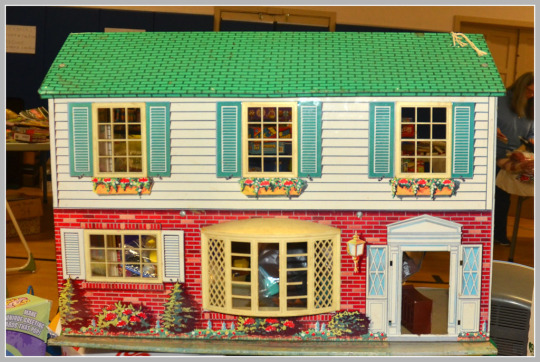
When I was little, I had one of these tin dollhouses that were popular in the 1950’s and 60’s. As a child growing up, I dreamed of someday living in a dream house just like the one I played with. I hoped for lots of bedrooms, a cute baby nursery, and a fireplace in the living room. Now I dream of owning another tin dollhouse like the one I had when I was little.
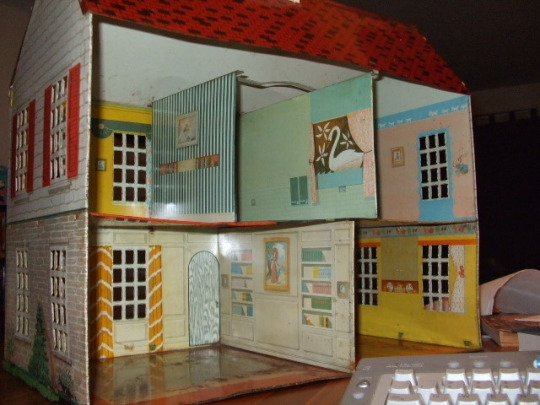
🏠 VINTAGE DOLLHOUSES: A BRIEF HISTORY OF MINIATURE HOUSES AND WHY WE LOVE THEM- While dollhouses may seem like timeless childhood playthings, this hasn’t always been the case – when they first emerged in the 17th century, they weren’t designed for children or playing!
Intended to impress and entertain guests, the first “miniature houses” or “cabinet houses”, as they were called, belonged to wealthy people in 17th century Germany, Holland and England. They were usually built in cabinets with hinged front doors (like a china cabinet), divided into floors and rooms that contained expensive miniature household objects, décor, and furniture. Then in the 18th century, it became popular for English elites to commission small-scale replicas of their own houses, with exact copies of all the inner rooms and furnishings, which they called “baby houses”.
While these miniature houses were the domain of upper-class adults, “Nuremburg Kitchens” (miniature dioramas of household kitchens) were given to little girls as far back as the 16th century. Their purpose was supposedly to teach young, future housewives about managing a household, but these tiny worlds would have captured the imagination of little children would have ultimately become playthings.
Fast forward to the 20th century, when mass-production, mail-order catalogues, and the rise of department stores bring dollhouses into the mainstream for middle-class children. Plastic dollhouse furniture was catching on in the 1940s, and after WWII it became the go-to material for dollhouse furnishings. Renwal and Ideal maintained leadership in the plastic dollhouse furniture market through the 1950s, but manufacturers including Plasco, Pressman, Marx, Reliable and others also enjoyed success during this period.
Steel (AKA tin-litho) dollhouses also gained popularity around the same time, first appearing in the late 1940s. This Woolworths advertisement from 1948 features Renwal plastic furniture sets alongside one of the earliest steel dollhouses, this Playsteel Federal-style dollhouse, manufactured by the American Can Co. Marx, T.Cohn, and others also made steel dollhouses, the most popular being “Colonial” styles and split-level ranch.
(Article from https://collectorsquests.com/tin-litho-dollhouses/)

3 notes
·
View notes
Text










Cap-D’Ail. Entre mer et montagne, le Cap d’Ail est une invitation au voyage. Le relief escarpé du versant monégasque fait plonger le Cap d’Ail du promontoire de la Tête de Chien jusqu’aux criques sauvages des plages de la Mala. Lieu d’art et de culture, le Cap d’Ail propose tout au long de l’année un large éventail d’événements artistiques dans des décors somptueux tels que l’amphithéâtre de la mer ou le Château des terrasses. La ville a commencé à voir le jour comme station d’hiver qui a connu un véritable essor touristique, grâce notamment à la construction de l’hôtel Eden.
En 1921, la commune de Cap d’ail a reçu le titre de station climatique, et aujourd’hui le Port de Cap d’Ail jouxte Fontvieille le prestigieux secteur moderne de Monaco.
De la fin du XIXème siècle jusqu’en 1940, cette commune azuréenne est devenue un lieu de villégiature pour des personnalités illustres, les Frères Lumière, inventeurs du cinéma moderne, sans oublier Sacha Guitry, comédien, metteur en scène de théâtre, cinéaste, ou encore les Princes Russes exilés. Après 1945, Greta Garbo et Winston Churchill y firent également construire de magnifiques villas.
#cotedazur#original photographers#photography#photographers on tumblr#photographe#photo#france#villagedefrance#tourism#francephotography#tourisme
3 notes
·
View notes
Text
How to Build a Ranch Home in The Sims 4 Like a Nerd

Ah, the Ranch. The Ranch is as American as Apple Pie... kinda. More on that in a minute. If you are looking for the perfect one-level family home that is beginner friendly, wildly customizable, and nearly everyone has lived in at some point, this is the build for you. Let's build!
If you prefer video tutorials, you can find that here.
The Ranch home originated in the American Southwest in the early 20th century, descended from styles like the Spanish Colonial, and started its spread across the states in the 1940s. Most have basements, where climate allows. This style is extremely versatile, which explains its popularity, and it was featured in popular at the time Western films, so it’s basically a movie star. This house can be anywhere, any size, and is as American as apple pie. (Apple pie was actually invented in England in the 1380s and wasn’t popularized in America until WWII, which is actually like the Ranch.) Anyway, although there are five subtypes of Ranch homes, they all have a few things in common: one story, although finished basements really add to the living area; open floor plans; low roofs; porches at front and back; family-oriented living; and are fairly simple shape-wise. One last fun fact: the main reason these homes took off was due to WWII vets receiving home loans upon returning to the states had few options, thanks to the Great Depression, and opted to have simple and stable Ranch style homes built. Alan Hess, author of The Ranch House, said “While architects in Western Europe and the Soviet Union met the need by building high-rise-apartment blocks, Americans created a consumer product that people wanted to buy. And that was the ranch-style house. It deserves respect because it solved the housing crisis of America in the midcentury.”
Floorplan
You will enter into the main living space, which has the living room at the front and the kitchen at the back. Of course, there have been many modifications and adaptations over the years, but this is Building like a Nerd so we stick with as original information as possible. The backyard-facing kitchen allowed the hardworking mother a clear view of her children as they played in the large backyard. Most bedrooms will be on the main floor, although some can be added to the basement if you have one. The overall footprint will be a rectangle, with front facing bump-outs on the left, right, or both sides. These homes were created with family life in mind, so a large deck and multiple child bedrooms are very common.



Exterior
The siding will be brick, siding, stucco, or some combination. This is a great build to use the wallpaper options that have automatic columns on the corners because it is so simple you likely won't have any issues with angles and whatever else it is that bugs them out. A garage is pretty key, but you can always use it as a gym or office space since we don't have cars...





You have a lot of freedom when it comes to landscaping. Simple suburban classics like a couple of hedges and hydrangeas are as applicable as a full fledged flower bed.

Interior
Because this home was so heavily featured in Western movies at the time of their initial construction, homes across the nation adopted the Western décor style. Patterned wallpapers, wood, paneling, iron decorative elements, and so on were incredibly common. The kitchen would be large enough for one or two people to cook together comfortably, with an island or table nearby for easy homework supervision. Bathrooms will be plentiful, as this is a new enough style that indoor plumbing was a major consideration.
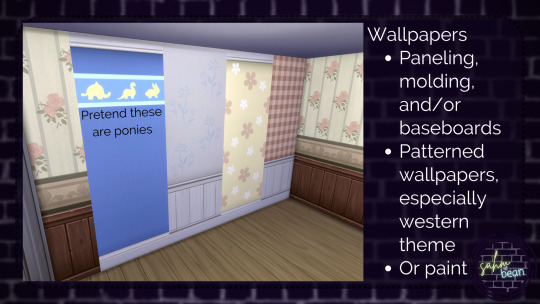


If you want to bring the Ranch into the 21st century, try these tips:
Replace all that wallpaper with some nice, plain, neutral paint
Instead of having siding and brick on the same wall section, break it up to have only siding on some parts and only brick on others (or stucco or stone or whatever else you are using; they ain't picky).
Update cabinets and bathroom fixtures.
If you would like to check out my build, it is on the gallery. My ID is sahmandbean and the lot title is Ranch Suburban Shell.
If you want to learn more, you can find all my resources in this Pinterest board.
You can find the full original video tutorial here.

Thanks so much for building with me today! I developed such a new respect for the Ranch home when I researched all of this, and all of those random western wallpapers suddenly make sense.
3 notes
·
View notes
Photo


“Ploumanac'h, Goémoniers sur la Grève" étude à la gouache de Mathurin Méheut pour le décor de l'Institut de Géologie de Rennes (circa 1940) à l'exposition “Mathurin Méheut, Arpenteur de la Bretagne“ au Musée de Pont-Aven, Bretagne, août 2022.
2 notes
·
View notes
Text
Isn't each canvas a journey in and of itself?
The voyage of Pakistani artist and thinker Abdur Rahman Chughtai (1897–1955), who produced a painting in his manner. This artist was influenced not just by Islamic art but also by Mughal Arts miniature paintings, Art Nouveau décor, and other modernist movements. Be a modern Muslim artist from South Asia, he was referred to as "the first prominent Muslim artist from South Asia." As time went on, he earned Pakistan's Hilal-i Imtiaz in 1960 and the Presidential Medal of Honor for Pride of Performance in 1968, in addition to the title "Khan Bahadur" in 1934. Chughtai's uncle, Baba Miran Shah Naqqash, taught him naqqashi in his local mosque. In 1911, he graduated from the Railway Technical School in Lahore with a diploma in electrical engineering. The Mayo School of Art, where Samarendranath Gupta, a protégé of Abanindranath Tagore, was Vice-Principal, was Chughtai's choice because of his passion in art and tiny paintings. He became a photographer and a drawing instructor after he graduated from high school. He rose through the ranks at the Mayo School's chromo-lithography department to become the department's lead instructor. Chughtai, It was in the 1940s that he began to develop his distinct style of painting, which was heavily influenced by Islamic art while yet preserving a distinct Art Nouveau flavour. It was derived from stories, folklore, and history of the Indo-Islamic world in addition to Punjab, Persia, and Mughal-ruled India. Chughtai's portrayal of Radhika as delicate and lovelorn stands out among the other portraits. There is a lamp with a stand on the left side of the image in a Mughal style described. This artwork necessitates the use of a high-quality Serigraph material (Silk Screen on Paper). Using tempera paint and the washing method of watercolour painting, this 1949 A.D. artwork depicts a young woman named Radhika, who is holding two lotuses in her hands and is dressed in a light-colored Ghagra, a red Choli, and a yellow Dupatta in an Indian style. Braided tresses in a dark shade of black trickle down her back. It's the arch of her eyebrow that sets her apart from the rest of the crowd. They provide the appearance of fragile, flexible, and beautiful ornaments. As a tribute to her love of Mughal art, a lamp painted in the style of the Mughal era stands on the left side of the artwork. Godhead has been touched or demonstrated by Radhika. Another impressive accomplishment is the artist's ability to use their imagination Because of the tranquilly and serenity they radiate, his lorn has always been a magnet for art enthusiasts.
2 notes
·
View notes
Link
Check out this listing I just added to my Poshmark closet: Roseville Pottery Leaf Acorn Green Pattern Vase 234 4" 3D Small chip on Base.
0 notes
Text
Undercurrent


Katharine Hepburn in REBECCA (1940), would seem like a terrible idea, and though it made a lot of money, Vincente Minnelli’s UNDERCURRRENT (1946, TCM, Criterion Channel) provides solid proof of that. Of course, UNDERCURRENT isn’t REBECCA. It isn’t even REBECCA-Lite or REBECCA maudit. It’s more REBECCA totally f*cked up. There’s just too much plot there.
She’s a professor’s daughter who falls for a wealthy industrialist (Robert Taylor) who’s come to buy her father’s research. For the first quarter hour, the film is more a delightful romantic comedy about a wallflower falling for a dashing, glamorous man as her father (Edmund Gwenn) and wise-cracking housekeeper (Marjorie Main) egg her on. Then they get married, and she starts feeling inadequate to mix with his sophisticated friends, which is something Hepburn doesn’t play very well. Then he starts threatening her whenever some unexplained secret about his brother (Robert Mitchum) comes up, and Hepburn isn’t very good at playing the victim either. And the two plots don’t really mesh. The one really has nothing to do with the other thematically. Nor does it help that Taylor is too plastic a movie star to work opposite Hepburn. Where she’s natural, he seems phony. When she resorts to phony tricks, it just doubles the phoniness. Mitchum is the only one of the three who’s totally believable, and there’s not nearly enough of him. When the script forces him to indulge in some high-flying romanticism, he just underplays it and makes it sound like the way anybody would talk. There’s also a good, brittle performance by Jayne Meadows in her film debut as a woman who’d gotten close to Mitchum. Minnelli and Karl Freund try to gussy it all up with a lot of dark shadows, which explains why it’s now considered a film noir. Where the director really shines, though, is in the film’s décor, particularly the contrast between Taylor’s country home, all traditionally over-stuffed, and Mitchum’s sleeker, more natural ranch house. When Hepburn, in one of the few decent costumes Irene designed for her, stands by the fireplace in the latter, you know who her true match is.
There is, however, one way the cockamamie plot could make sense, When Gwenn suggests Hepburn could soon be exchanging vows with Taylor, there’s a slow dissolve to their wedding as the vows she quotes in the earlier scene become the ones she’s saying for real. If you look on the wedding and everything that follows are her fantasy it becomes a more grown-up THE WIZARD OF OZ. It’s Hepburn’s dream of what a horror marriage can be and an affirmation that she’d be better off as an ace or a lesbian. I’d lay money that Main would treat her better than Taylor does, and we’d have a lot more fun watching it, too.
#katharine hepburn#robert taylor#robert mitchum#vincente minnelli#marjorie main#edmund gwenn#jayne meadows#melodrama#film noir#karl freund
1 note
·
View note
Link
Check out this listing I just added to my Poshmark closet: This is a Vintage Westmoreland Milk Glass Paneled Grape Footed Lipped Comport.
0 notes
Text
Timeless Charm: Walnut Coffee Table Mid Century Era
In furniture design, few pieces encapsulate the mid-century era's timeless charm and enduring appeal quite like the walnut coffee table. With its sleek lines, warm tones, and understated elegance, this iconic piece of furniture continues to captivate enthusiasts and interior designers alike. Among the myriad mid-century furnishings, the walnut coffee table mid century stands out as a symbol of sophistication and craftsmanship. Let's delve into the allure of this classic piece and explore why it remains a coveted choice for modern homes.
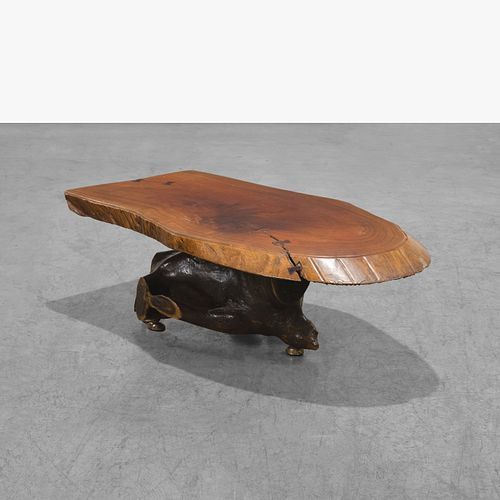
The Mid-Century Era: A Golden Age of Design:
The mid-century era, from the 1940s to the 1960s, marked a pivotal period in design history. Characterized by a fusion of form and function, this era created iconic furniture pieces that continue to inspire contemporary trends. At the heart of this movement was a commitment to simplicity, clean lines, and organic materials. It was during this time that the walnut coffee table emerged as a quintessential example of mid-century design ethos.
Timeless Charm of Walnut:
Walnut, with its rich, warm hues and distinctive grain patterns, became the preferred choice of material for furniture makers during the mid-century era. Renowned for its durability and versatility, walnut exudes a sense of luxury and sophistication that transcends trends and fads. Whether in its natural state or stained to enhance its depth of colour, walnut possesses an innate elegance that elevates any space.
Sleek and Functional Design:
One of the defining features of the walnut coffee table from the mid-century era is its sleek and functional design. Characterized by clean lines and minimalist aesthetics, these tables were crafted to emphasize both form and function. Featuring simple yet striking silhouettes, they effortlessly complement various interior styles, from modernist to eclectic.
Versatility in Décor:
Another reason for the enduring popularity of the walnut coffee table is its versatility in décor. Whether placed in a cosy living room as a centrepiece or used to anchor a minimalist sitting area, these tables effortlessly blend into any setting. Their timeless appeal makes them equally at home in a mid-century-inspired space or a contemporary interior, adding a touch of sophistication wherever they go.
Craftsmanship and Quality:
Central to the allure of the walnut coffee table is the craftsmanship and attention to detail that went into its creation. During the mid-century era, skilled artisans meticulously crafted each piece by hand, ensuring unparalleled quality and durability. From the precision joinery to the seamless finish, these tables exemplified the highest standards of craftsmanship, making them heirloom-worthy pieces cherished for generations.
Bidsquare: Preserving Heritage Through Online Auctions
In today's digital age, platforms like Bidsquare play a crucial role in preserving and showcasing the legacy of mid-century furniture. Through online auctions, Bidsquare connects collectors, enthusiasts, and connoisseurs with a curated selection of vintage and antique pieces, including walnut coffee tables from the mid-century era.
By offering these timeless pieces to a global audience, Bidsquare ensures that the legacy of mid-century design continues to thrive and inspire future generations. Whether you're a seasoned collector or a design enthusiast, Bidsquare provides a platform to explore, discover, and acquire iconic pieces of furniture embodying the mid-century era's timeless charm.
In conclusion, the walnut coffee table from the mid-century era remains a symbol of timeless charm and enduring elegance. With its sleek design, warm tones, and impeccable craftsmanship, this iconic piece continues to capture the imagination of design enthusiasts worldwide. Whether showcased in a modernist loft or a cosy living room, the walnut coffee table adds a touch of sophistication and refinement to any space. And thanks to platforms like Bidsquare, these timeless pieces are readily accessible to collectors and connoisseurs, ensuring that the legacy of mid-century design lives on for generations to come.
Visit Bidsquare's Auction Near Me page to discover upcoming auctions near you. Bidsquare facilitates a global audience, allowing art lovers worldwide to participate in the excitement of the auctions hosted at this venerable institution.
If you are interested in auctions, you can explore the auction house near me to discover even more exceptional auction venues.
#Walnut Coffee Table Mid Century#online auctions#upcoming auction#live auctions#auction house near me
0 notes
Link
0 notes
Text

Kitchen Towel
The embroidered design on this linen towel reserves it for kitchen décor rather than for drying dishes. The towel is part of a days-of-the-week set made from a needlecraft kit, a popular creative endeavor in the 1940s, when smaller, single-family homes and new appliances eased the burden of housework for middle-class women. In contrast to housekeeping tasks such as ironing, baking, and sewing depicted on the Monday through Saturday towels, the woman rests on “Sunday.” Blanche Ford Hart (1897-1992) likely embroidered these towels for use in the family’s kitchen. (1943)
source
#found by kino#vintage#embroidery#id in alt text#cross stich#kitchen decor#i put id because the part of description fitted better there
0 notes
Text

DIMANCHE 23 JUILLET 2023 (Billet 1 / 3)
Nous vous l’avons dit dans notre dernière Newsletter, en juillet-août une grande partie des « locaux » sont partis, les touristes, eux, sont à la Tour Eiffel, au Musée du Louvre, à Montmartre ou sur des Bateaux-Mouche… et Paris, enfin, nous appartient !
Nous repérons comme chaque année sur des Sites spécialisés (« Sortir à Paris », entre autres…) des idées de sortie et nous découvrons de nouveaux endroits, de nouvelles balades, de nouvelles Galeries d’Art, de nouveaux p’tits restos, et souvent ce sont de belles surprises.
Hier, c’est une petite exposition, LEONOR FINI : « DANS L’ATELIER DE L’ARTISTE », dans le 7e arrondissement, qui nous a attirés. JM y était allé la veille. Il a été très courtoisement accueilli par une charmante personne, qui lui a même commenté certaines œuvres et qui l’a autorisé à prendre des photos quand il reviendrait le lendemain avec sa femme (JM lui ayant expliqué que c’était souvent sa façon de procéder : repérage seul dans un premier temps, puis visite à deux si cela en vaut la peine…).
Sachez qu’au contraire d’une expo classique, dans cette galerie, toutes les œuvres sont à vendre. Nous connaissons maintenant le prix de certaines, évidemment assez élevé, Leonor Fini étant une artiste très connue, mais d’autres sont beaucoup plus abordables.
La galerie Minsky gère l’héritage pictural de l’artiste et si vous appréciez ses dessins, il y a de vrais petits trésors en réserve dans des tiroirs. Vous pourriez par exemple vous en offrir un pour 1500€.
Les œuvres que vous verrez ici ne sont bien sûr pas les plus connues car la plupart ont été réalisées sur papier pour illustrer des romans (E.A. Poe, Shakespeare…) ou des esquisses de costumes pour des ballets. Mais elles sont toutes intéressantes et ce sont des originaux.
Notre conseil : allez y faire un tour, « juste pour le plaisir des yeux » (comme on dit au Maroc…) mais aussi pourquoi pas, si vous êtes amateur et que vous craquiez, repartir avec un Leonor Fini qui trouvera sûrement une jolie place sur un mur de votre appartement ou de votre maison.
________________________________
LEONOR FINI : « DANS L’ATELIER DE L’ARTISTE »
15/06/2023 – 16/09/2023
La Galerie Minsky est heureuse d’annoncer l’ouverture de sa nouvelle exposition Leonor Fini, mettant en lumière une facette moins connue de son œuvre, celle d’une artiste très attachée à l’utilisation du papier. Une sélection d’œuvres sur papier qui étaient auparavant conservées dans l’atelier de l’artiste, faisant partie jusqu’à présent de sa collection personnelle, y compris plusieurs huiles sur papier et sur toile.
Cette sélection insiste également sur l’importance de la littérature pour l’artiste et son œuvre, notamment à travers les illustrations réalisées pour « La Tempête » de Shakespeare, 1965, mais aussi pour l’intégrale des œuvres imaginatives et poétiques d’Edgar Allan Poe, 1966. Leonor Fini a illustré près d’une cinquantaine de livres et chéri ces pièces que nous avons la chance d’exposer.
Réalisées entre 1940 et 1990, ces œuvres témoignent de l’évolution et du renouvellement constant de l’œuvre de l’artiste au gré de ses inspirations. Théâtre, opéra et ballets pour lesquels l’artiste a créé des décors et des costumes sont également présentés, notamment ceux créés pour « Les Demoiselles de la Nuit », chorégraphiés par Roland Petit en 1947, parmi beaucoup d’autres.
(Source : « Texte trouvé sur le Site de la galerie »)
GALERIE MINSKY
37 Rue Vaneau
75007 Paris 7e
Horaires
Du mardi au samedi : 10h30 - 13h, 14h – 19h
Fermé les dimanche et lundi
La galerie sera fermée à partir du 29 juillet jusqu’au 29 août
Métro : Sèvres-Babylone ou Saint François-Xavier
Pour avoir un aperçu des œuvres disponibles à la vente, cliquez sur le lien ci-dessous, puis, tout en bas, sur « Boutique ».
Leonor Fini (leonor-fini.com)




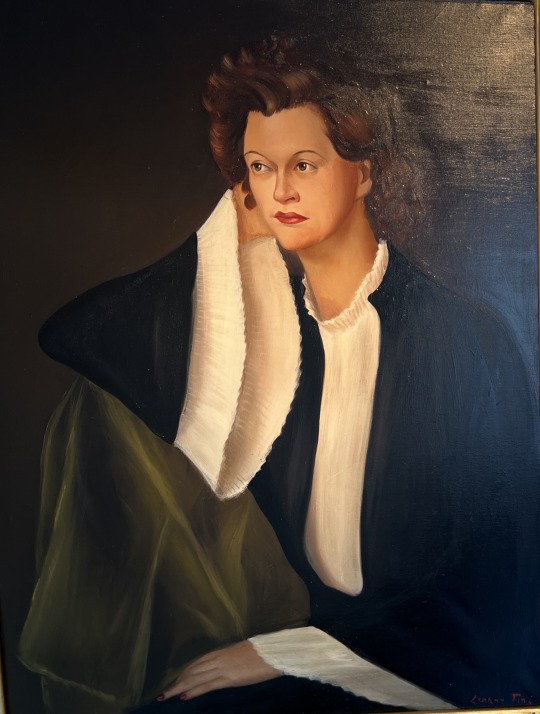
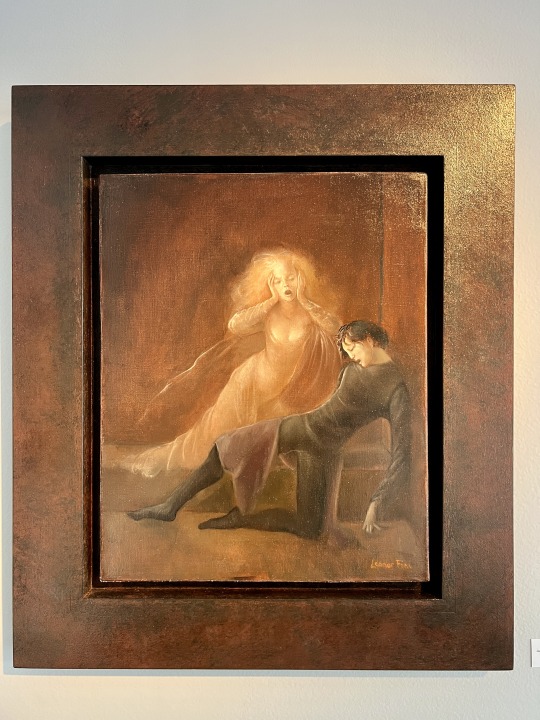
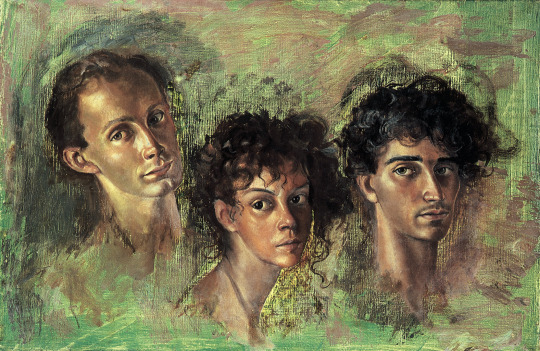

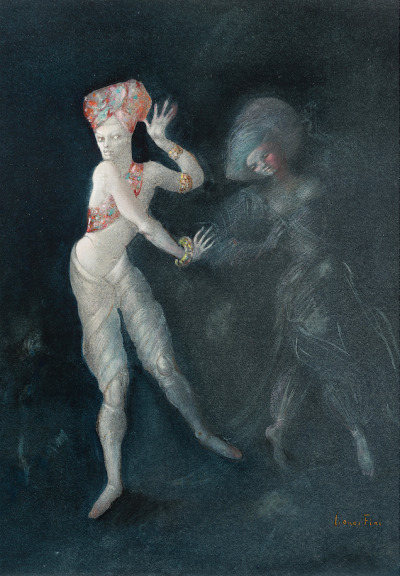
Leonor Fini est une artiste que nous apprécions beaucoup tous les deux. Pour preuve, une de ses « Lithos » est accrochée au-dessus du buffet de notre salle à manger.



1 note
·
View note
Video
youtube
QUARTIER ART DÉCO - MIAMI BEACH - FLORIDE
Situé à l'extrémité sud de South Beach, le quartier Art Déco de Miami se compose de centaines de bâtiments conçus dans un style architectural unique.
Bien que la plupart des bâtiments datent de 1925 à 1940, ils ont été rénovés et entretenus pour faire de Miami une destination touristique si glamour.
L'Art Déco est un mouvement artistique qui a émergé dans les années 1920 et qui a atteint son apogée pendant la Grande Dépression, lorsque les Américains se sont attendus à cette architecture qui a permis de remonter le moral du pays.
Les bâtiments de style Art Déco se caractérisent principalement par une géométrie élémentaire (cubes, sphères et lignes droites) avec une grande abondance ornementale, la fonction de l'Art Déco étant plus décorative que fonctionnelle.
Les sols en terrazzo, les moulures de plafond, les couleurs tropicales et pastel, les rayures parallèles, et surtout, les enseignes aux néons lumineux, sont quelques-uns des éléments les plus importants du style Art Déco.
Le quartier Art Déco est considéré comme un trésor par les habitants de Miami. Il serait impossible de trouver un autre endroit avec un tel nombre de bâtiments de ce style particulier et, surtout, en parfait état de conservation après presque cent ans. En plus, cette zone colorée comprend une grande partie de l'avenue Ocean Drive, l'un des lieux les plus touristiques et animés de la ville.
Si vous voulez en savoir plus sur ce style architectural, vous pouvez vous rendre au Centre d'accueil du quartier Art Déco de Miami pour réserver une visite de 90 minutes avec un guide bénévole ou louer un audio-guide.
Pour découvrir les bâtiments les plus importants de la zone, vous pouvez commencer votre visite par l'extrémité sud d'Ocean Drive, entre les rues 6 et 7.
Hôtel Park Central (630, Ocean Drive).
Hôtel Colony (736, Ocean drive) .
Hôtel Waldorf Towers (860, Ocean Drive).
Hôtel de brise-lames (940, Ocean Drive).
Hôtel Edison (960, Ocean Drive).
Centre d'accueil du quartier Art Déco (1001, Ocean Drive).
Hôtel Victor (1144, Ocean Drive).
Hôtel Leslie (1244, promenade Ocean) .
Carlyle (1250, Ocean Drive).
Hôtel Crescent (1400, Ocean Drive).
Hôtel Mc Alpin (1424, Ocean Drive).
En tournant à gauche sur la 15ème rue :
Haddon Hall (1500, avenue Collins).
En marchant sur Collins Avenue en direction du sud et en prenant à droite sur la 13th street
Bureau de poste principal de Miami Beach (1300, Washington Avenue) .
Hôtel Astor (956, avenue Washington).
En retournant sur la 10e rue jusqu'à l'avenue Collins.
Maison d'Essex (1001, avenue Collins).
L'Hôtel (801, Collins Avenue).
Source: https://www.miami.fr/quartier-art-deco
***************
AUTRES VIDÉOS DE CE ROAD TRIP:
https://www.youtube.com/playlist?list=PLlRroQCNvchsdvRQOTUATm7OU6BabhYIF
ABONNEZ-VOUS ► https://www.youtube.com/c/SouthAngelVideo?sub_confirmation=1
SUIVEZ NOUS :
• BLOGGER ► http://southangelvideo.blogspot.ca/
• INSTAGRAM ► https://www.instagram.com/annestrasbourg/
• FLICKR ► http://www.flickr.com/photos/anne_strasbourg/collections/
• TWITTER ► https://twitter.com/AnneStrasbourg
0 notes